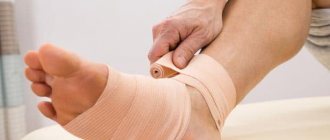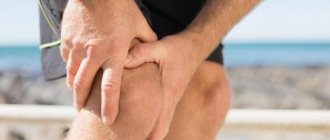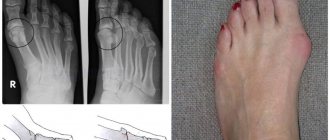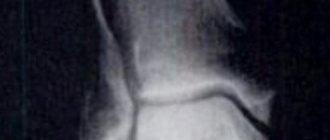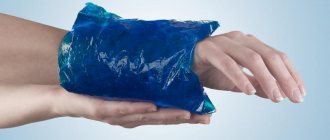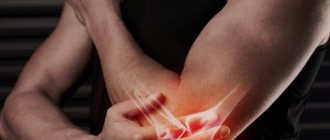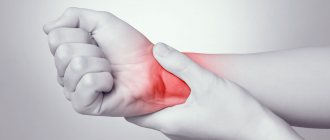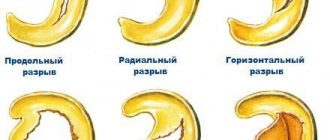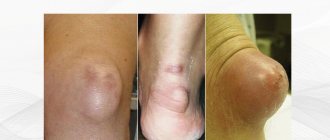A sprain is a common injury characterized by micro-tears of fibers or individual parts of the ligament. It often occurs in standard everyday situations, for example, when twisting a leg. Most often observed in athletes and people leading an active lifestyle.
Symptoms of a sprain depend on the stage of the pathological condition. In any case, at the moment of injury, sharp pain occurs. It intensifies when trying to use the affected limb and subsides a little during the period of repose. Sometimes, when stretched, a characteristic pop is heard - this indicates the rupture of most of the fibers. At the first stage of the pathology, slight swelling forms, movements are somewhat limited, and pain is moderate. In the second, bruising appears, swelling is greater, movements are painful and limited, and support on the injured leg is difficult. The third stage is characterized by significant swelling, multiple bruises, instability of the joint, severe limitation of movement and the inability to lean on the leg.
Description of ankle ligament injury
One of the most common injuries affecting the modern population is ankle ligament damage. Moreover, in 12% of cases this is due to the presence of tears, tears and sprains in the ankle area. Dislocations or subluxations in the above zone can also provoke a violation of the integrity of the ligamentous apparatus.
Most often, injury to the ankle ligaments occurs during cold periods, when a person overcomes icy surfaces. Often, the cause of such damage can be moving on uneven terrain or jumping from a height.
Diagnostics
Diagnosis of ligament damage begins with a detailed medical examination of the patient, collection of complaints and medical history, as well as palpation of the affected area. To make a final diagnosis, the patient is prescribed a series of examinations that allow one to assess the condition of the internal structures of the joint, namely:
- X-ray examination (as a rule, X-rays are taken in two projections);
- ultrasound examination of the joint condition;
- magnetic resonance imaging, which is prescribed in the most difficult cases in terms of diagnosis and is the most informative method for diagnosing traumatic lesions of bone joints.
The answer to the question whether a patient has a sprain or rupture of a joint ligament can only be given by a professional doctor, based on data from an objective examination of the affected area, as well as on the results of additional diagnostic methods for the affected area.
First aid for ankle ligament injuries
Sometimes an ankle sprain is compared with injuries resulting from a twisted foot. However, in this case it is wrong to talk about a sprain, since bruising and swelling occur. At the time of injury, tears occur in the area of the ligamentous apparatus. In turn, when stretched, the integrity of some fibers is disrupted, but the functional characteristics remain unchanged.
If signs of injury are detected in the ankle area, the person should receive immediate assistance. First of all, it is necessary to minimize the load on the ankle joint. This will prevent deterioration of the ligaments and tendons in the future. The following measures should also be applied to the victim:
- Apply a cold compress. This will make it possible to prevent increased swelling and the spread of bruising to nearby tissues. In this case, the patient notes a loss of sensitivity in the affected area, which helps eliminate pain. Moreover, by using a cold compress immediately after injury, it is possible to reduce the duration of the treatment process. Apply the bandage to the painful area for 20 minutes;
- Using an elastic bandage. To ensure immobility of the damaged joint, it is recommended to use a fixing bandage. Experts recommend avoiding tight bandaging, as it can cause loss of sensation in the fingers and increased swelling. However, such a bandage will prevent the occurrence of ruptures in the future;
- Placing the leg in an elevated position. The injured limb should be placed on pillows or on a chair (in a sitting position). This will relieve pain in the ankle joint and eliminate swelling in nearby tissues.
The use of warming agents is strictly prohibited during the period of first aid. It is not recommended to do alcohol rubbing and take a hot shower. It should be remembered that the fixing bandages are removed before resting at night.
Recovery period
Here, muscle relaxation comes first - muscle relaxation, which allows you to break the incorrect pattern of movements that arose after an injury. It can be carried out using electrical, thermal influences, massage. Myorelaxation is followed by myocorrection - the creation of a compensated stereotype of movements and myotonization - the consolidation of the correct settings.
To solve the last two problems, a special simulator has been developed. This is a loop complex consisting of a system of grids and suspensions, which allows you to remove the force of gravity and friction, so that the patient can easily repeat the necessary movements tens and hundreds of times, increasing muscle strength. In fact, the patient exercises at the complex in zero-gravity conditions, like an astronaut.
Exercises in the pool are also very useful - they allow you to temporarily relieve the load of gravity from a sore spine and speed up the process of strengthening the muscle corset. The therapeutic effect is enhanced in a pool filled with brine water. This is a special medicinal substance, which is a waste product of bacteria that live on the surface of mud deposits in some lakes. In dried form, brine is added to the pool water and has an anti-inflammatory, analgesic effect, improves tissue metabolism, lymph and blood circulation. All this allows you to achieve better results and reduce the time of discharge from hospital.
Almost all the time before discharge, especially in the first period after the injury, sessions with a psychotherapist are important. Patients are taught to create a dominant - the mood to perform the correct movement in the affected joint. The main thing is to subordinate the dominant to your will, control it in order to suppress pathological impulses in the affected part of the spine. Muscle relaxation training is very important here, on the basis of which all methods of autogenic influence are implemented.
Treatment of grade 1–2 ankle ligament damage
As a rule, with a slight injury to the ligamentous apparatus, the patient does not notice any signs of the disease. In the first days, the pain syndrome does not make itself felt even with increased physical activity.
Increased swelling, expansion of the bruise area and an increase in the focus of inflammation are observed in the next day. The patient begins to limp, guided by the desire to eliminate discomfort.
Signs of a grade 2 ankle sprain make themselves felt immediately after injury and are accompanied by intense pain. The appearance of bruising and swelling is monitored approximately 60 minutes after the incident. To eliminate the possibility of a violation of the integrity of the ankle, you should immediately contact a traumatologist.
If a patient is diagnosed with a grade 1-2 ankle sprain, treatment does not require hospitalization. In the first 48-72 hours after injury, it is recommended to apply a fixing bandage and a cold compress:
- It is advisable to use an elastic bandage of medium stretch for 2 weeks;
- A bandage made using plaster should not be worn for more than 7 days. Otherwise, it will be difficult to restore muscle tone.
Non-steroidal anti-inflammatory drugs are considered the most effective drugs when the ankle ligaments are damaged. You can also treat ankle ligaments with special gels and ointments: Diclofenac, Ketorolac, Nimesulide, Indomethacin, etc. Such products are intended exclusively for external use, but they can have a powerful analgesic and anti-inflammatory effect.
The doctor may also prescribe ointments to restore blood flow. These include Lyoton gel and Heparin ointment. Thanks to their use, it is possible to improve blood microcirculation and provide active nutrition of the ligaments with important biological and nutrients.
Anatomical features
From a medical point of view, knee sprains require recovery due to the severe muscle spasm that occurs immediately during the injury. Damage to any of the bones will lead to the development of joint disease. Some injuries immediately manifest themselves as unbearable pain. But it also happens that a person continues to lead an active lifestyle, ignoring alarming symptoms, thereby aggravating his condition. Treatment in this case will be longer; it is difficult to guarantee a 100% positive result even for the best specialists. Therefore, if the slightest symptoms appear and suspicions that recovery is required after a sprained knee joint, it is better to immediately contact Dr. Glazkov’s clinic in Moscow. Here, patients will be given an accurate diagnosis and, based on the data obtained, qualified treatment will be prescribed.
Help with grade 3 ankle sprains
More serious injuries may result in complete rupture of the ankle ligaments. In this case, signs identical to a bone fracture appear. The patient loses the ability to move because he feels severe pain and the inability to step on a limb. Such symptoms are caused by changes in the anatomical relationship of the component parts of the joint. Characteristic features of the disease also include the rapid spread of hematoma and swelling over the entire area of the ankle.
In case of rupture of the ankle ligaments, conservative treatment is practically not prescribed, which is due to the following points:
- There is a weak ability of damaged fibers to fuse;
- It may not be possible to fully restore the functional characteristics of the foot;
- If surgical intervention is refused, there is a risk of recurrent ankle injury due to ankle instability.
Planned surgical intervention is performed in case of complete separation of the ligament from the bone. To restore its continuity, bone and tendon sutures are applied. After completion of the surgical procedure, the patient is recommended to wear a bandage made of plaster for 21-28 days. During the entire rehabilitation period, the patient must take medications that improve blood supply to the tissues in the ankle joint. Medicines that expand the vascular lumens are also prescribed: Venarus, Detralex and Phlebodia.
Make an appointment Online booking
- Clinic on Krasnopresnenskaya +7 (499) 252-41-35 Volkov lane, 21
- Clinic on Varshavskaya +7 (499) 610-02-09 Varshavskoe highway, 75, building 1
- Clinic in Annino +7 (495) 388-08-08 Varshavskoe highway, 154, building 1
Physiotherapy for ankle ligament injuries
For those wondering how to treat an ankle sprain, undergoing physical therapy is a must step. When implementing such measures, you can get a more tangible positive effect than after taking medications.
In case of first and second degree injuries, physiotherapy should be resorted to within 72 hours after the start of treatment. They can also be performed after surgery, during the rehabilitation period. An experienced specialist will help you choose the most effective physiotherapy procedures. At the same time, he takes into account the individual nuances of each patient, as well as:
- Intensity of damage;
- The ability of tissues to regenerate;
- Presence in the anamnesis of pathologies caused by malfunctions of the cardiovascular system.
Initially, the patient is recommended to undergo a procedure that involves exposure to direct electric current and special medications. For this purpose, a cotton swab soaked in a special medicine is applied to the damaged area, and metal plates are placed on it. By using electrical impulses, the medicine can reach the deepest layers of tissue. As a rule, during the procedure, agents with analgesic and anti-inflammatory effects are used. In some situations, to speed up the process of fusion of ligaments that were previously torn from the base, it is recommended to use chondroprotectors.
Also during the recovery period, the following techniques can be used: ultrasound exposure, paraffin baths, magnetic therapy and shockwave therapy.
Treatment of ankle ligaments with shock wave therapy
The best effect in restoring the ankle joint can be achieved using the shock wave method. It is based on the influence of acoustic waves, which ensures rapid regeneration processes:
- Hematomas disappear;
- Ensures active crushing of calcium deposits and destruction of connective tissue cords (scars);
- Blood flow improves;
- Metabolic processes are accelerated.
However, in order to achieve a better result when restoring the deltoid ligament of the ankle joint, an integrated approach should be provided - combining the UVS technique with the use of medications. This will allow you to quickly cope with pain when moving, eliminate swelling and improve the motor activity of the joint.
According to most patients, it is possible to obtain noticeable improvements after shock wave therapy after the first sessions. Lost lightness returns, the feeling of stiffness and discomfort goes away, and overall well-being improves.
In our clinic, the SWT procedure is performed by orthopedic doctors with extensive experience, who have the skills to work with special equipment and provide a personal approach to each visitor. At the same time, the first visit to our medical center is carried out with a 20% discount.
Symptoms of a sprained ankle
Injuries of 1st and 2nd degrees are partial micro and macro ruptures of soft tissue structures.
When severely affected, they tear off the bone, causing the leg to completely lose functionality. When an ankle sprain occurs, pain of varying intensity occurs, regardless of the degree. Due to the high permeability of blood vessels and pressure on the capillaries, swelling forms and pain increases. If the ankle is sprained, damage to the walls of large vessels occurs, a hematoma appears with blood filling, and the skin becomes blue-purple. If measures are not taken, an inflammatory process develops - ligamentitis, which affects the tendons. The patient may hear sounds similar to clicks when moving or moving his fingers, caused by loss of integrity of the annular ligament.
Orthopedic surgeon Andrey Yurievich Sidenkov comments:
Sprained ligaments extremely limit the range of rotation and mobility. At grades 2 and 3, it is almost impossible to step on your foot. With complete separation of solid tissue structures, abnormal joint activity is observed.
Exercise therapy to strengthen the ankle joint and ligaments
Physical therapy can also improve the functional activity of ligaments and tendons. The initial step involves a light warm-up. More complex exercises are gradually introduced. The main principle of exercise therapy is the absence of pain. When engaging in physical education, you should adhere to the following rules:
- Complete rest for extended periods of time should be avoided;
- It is necessary to avoid increased stress on the joint.
One of the most effective and mandatory exercises for all patients with this disease is walking on their heels and toes several times a day. Experts also advise performing extension/flexion of the foot, combining them with rotational movements.
In the absence of timely measures for first-degree pathology, serious complications may arise in the future. These include: diseases of the joints of inflammatory etiology, pathological flattening of the foot, dislocations, deforming osteoarthritis.
The medical center employs competent specialists who will provide first aid, perform all the necessary examinations and draw up a treatment plan, the implementation of which will help avoid irreversible consequences in the future. Our clinic performs X-ray examination, ultrasound and surgery. However, the priority and most effective way to restore the ankle joint is shock wave therapy. When implementing this technique, modern Swiss equipment is used, which allows you to get a quick and effective result.
How to avoid ankle ligament injuries?
In order to minimize the risk of joint injury, experts recommend adhering to the following measures:
- Ensure sufficient and regular physical activity to maintain the necessary elasticity of the ligaments;
- Provide moderate loads on the limb;
- Use comfortable shoes with low heels (no more than 7 cm);
- Perform a special set of exercises to strengthen the ankle joint and ligaments;
- Try to maintain normal weight;
- Timely treat pathologies that have a negative impact on the musculoskeletal system.
What other injuries can be treated with MBST?
Indications for the use of the MBST method are also:
- Achilles tendon injuries.
- Tendon and ligament injuries, such as a partial tear of the medial collateral ligament of the knee or tendinitis in patellar tendon syndrome.
- Ankles (acute and chronic ligament injuries, including strains after overload).
- Hip (muscle injuries).
- Knee joints (jumper's knee, cartilage and meniscus damage).
- As a conservative addition to cartilage wear/degradation and in cases after arthroscopy.
- Bone contusion/Bone swelling, osteochondritis dissecans or bone necrosis, pseudarthrosis, fractures and stress fractures.
